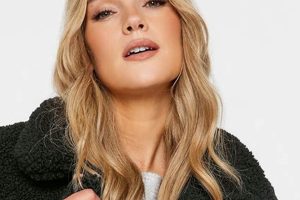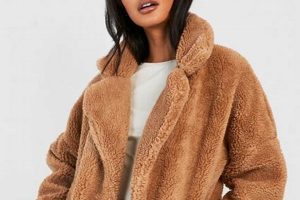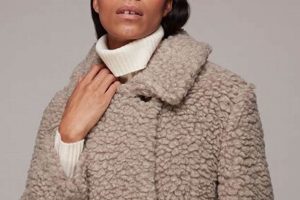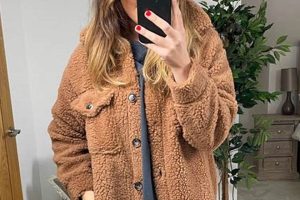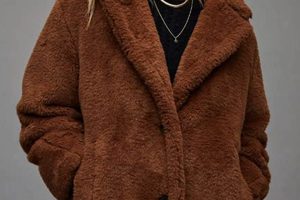A warm, fashionable ensemble centered around a coat made from a soft, plush material resembling a teddy bear’s fur is a popular choice for colder weather. This typically involves pairing the coat with complementary garments and accessories to create a cohesive and stylish look. Examples include combining the coat with jeans and boots for a casual appearance or dressing it up with a skirt and heels.
Such ensembles offer both comfort and style during autumn and winter months. The soft texture provides warmth and a cozy feel, while the coat’s versatility allows for adaptation to various settings, from casual everyday wear to more dressed-up occasions. The rising popularity of this style can be attributed to its blend of practicality and fashionable appeal, contributing to its presence in contemporary fashion trends.
This discussion will further explore various aspects of styling these ensembles, offering guidance on selecting appropriate accompanying pieces, accessorizing effectively, and adapting the look to different body types and personal styles.
Styling Tips for Teddy Coat Ensembles
Successfully styling a teddy coat ensemble involves careful consideration of complementary garments and accessories. These tips offer guidance on creating balanced and fashionable looks.
Tip 1: Balancing Proportions: Opt for slim-fitting bottoms like skinny jeans or leggings to balance the coat’s voluminous nature. Wider leg styles can work, but require careful attention to overall proportions to avoid a bulky silhouette.
Tip 2: Layering Effectively: Lighter layers like sweaters or turtlenecks work well underneath, providing warmth and visual interest. Avoid overly chunky knitwear to prevent a constricted appearance.
Tip 3: Footwear Choices: Versatile footwear options include ankle boots, knee-high boots, or sneakers, depending on the desired aesthetic. Consider the overall outfit’s formality and the weather conditions when selecting footwear.
Tip 4: Accessorizing Strategically: Scarves, hats, and gloves can add warmth and personality. Choose accessories that complement the coat’s color and texture without overwhelming the overall look.
Tip 5: Color Coordination: Neutral-colored coats offer versatility, pairing well with various outfits. For bolder colors, consider a more monochromatic approach to maintain balance.
Tip 6: Adapting to Different Styles: Dress up the ensemble with tailored trousers and heels or maintain a casual vibe with jeans and sneakers. The coats adaptability allows for a range of styles.
Tip 7: Considering Length and Fit: Coats come in various lengths; choose a length that complements one’s height and body type. Proper fit is crucial for both comfort and aesthetic appeal.
By following these guidelines, one can create stylish and comfortable ensembles suitable for various occasions and weather conditions.
These practical tips provide a solid foundation for incorporating a teddy coat into one’s wardrobe. Experimentation and personal preference further refine individual style.
1. Coat Style
Coat style significantly influences the overall aesthetic of a teddy coat outfit. Variations in length, silhouette, and detailing contribute to distinct looks, ranging from casual to sophisticated. A cropped teddy coat, for instance, creates a more youthful and modern feel, often paired with high-waisted trousers or skirts. This style emphasizes proportion and can be a flattering choice for those seeking to elongate the leg line. Conversely, a longer, more oversized teddy coat offers a relaxed and cozy vibe, suitable for casual outings and colder temperatures. Such styles often pair well with slim-fitting bottoms to balance the overall silhouette. The presence or absence of features like hoods, belts, or pockets further impacts the coat’s style and practicality.
Understanding the interplay between coat style and the desired overall aesthetic is crucial for creating a successful ensemble. A belted teddy coat, for example, can cinch the waist and create a more defined silhouette, while a hooded version offers added warmth and a more casual appearance. The choice of coat style should also consider the intended occasion and personal style preferences. A tailored, shorter teddy coat might be suitable for a smart-casual event, whereas an oversized, longer version might be preferred for everyday wear. Careful consideration of these elements ensures a cohesive and stylish outfit.
Ultimately, selecting the appropriate teddy coat style establishes the foundation for a well-balanced outfit. It influences the overall silhouette, dictates compatible accompanying garments, and contributes to the desired aesthetic, whether casual, chic, or something in between. A thorough understanding of these nuances empowers informed choices and contributes to a stylish and functional wardrobe.
2. Fabric and Texture
The inherent appeal of a teddy coat outfit stems significantly from its distinctive fabric and texture. These elements contribute not only to the garment’s visual appeal but also to its comfort and warmth, making them crucial considerations when selecting and styling such an outfit. A deeper understanding of these aspects enhances appreciation for the garment’s overall aesthetic and functional qualities.
- Material Composition
Teddy coats typically utilize synthetic fabrics like polyester or acrylic, chosen for their soft, plush texture and ability to mimic the feel of shearling or faux fur. These materials offer excellent insulation and are often more affordable and easier to care for than natural alternatives. The specific blend of fibers impacts the coat’s softness, durability, and overall appearance. For instance, a higher polyester content might contribute to a sleeker, more durable finish, while a higher acrylic content might result in a softer, more plush feel.
- Pile Length and Density
Variations in pile length and density influence the coat’s texture and warmth. A denser, longer pile provides a more substantial and luxurious feel, offering greater insulation against colder temperatures. Shorter, less dense piles offer a lighter, less bulky option, suitable for milder weather or layering. The pile’s characteristics also affect the coat’s drape and overall silhouette, contributing to its visual appeal.
- Texture Variation
While the classic teddy coat boasts a uniform, plush texture, variations exist, including coats with subtle texture variations or embossed patterns. These variations can add visual interest and dimension to the garment. For example, a crinkled or wavy texture adds a unique tactile element, while an embossed pattern introduces a subtle design element without compromising the coat’s signature softness.
- Maintenance and Durability
The chosen fabric impacts the coat’s durability and care requirements. Synthetic materials generally offer greater resilience against wear and tear and are often machine washable, making them a practical choice for everyday wear. However, proper care, including adhering to manufacturer instructions, is essential for maintaining the coat’s appearance and prolonging its lifespan. Considerations such as shedding, pilling, and resistance to moisture also influence the long-term satisfaction derived from the garment.
The interplay of material composition, pile characteristics, and texture variations contributes significantly to the overall aesthetic and performance of a teddy coat outfit. Careful consideration of these factors ensures both a stylish and functional garment suited to individual needs and preferences. By understanding the nuances of fabric and texture, one can make informed choices that enhance the enjoyment and longevity of this versatile wardrobe staple. Ultimately, these characteristics define the tactile and visual experience of the garment, influencing how it drapes, feels, and complements other elements of the outfit.
3. Color Coordination
Color coordination plays a vital role in creating a harmonious and visually appealing teddy coat outfit. A well-chosen color palette enhances the coat’s texture and overall aesthetic, contributing to a polished and stylish appearance. Strategic color choices can create various effects, from classic and understated to bold and eye-catching. Understanding the principles of color coordination allows for informed decisions regarding accompanying garments, accessories, and footwear, ensuring a cohesive and flattering ensemble.
- Neutral Foundation
Neutral-colored teddy coats, such as beige, cream, camel, or gray, offer versatility and serve as an excellent foundation for various outfit combinations. These hues pair seamlessly with a wide range of colors, allowing for experimentation with different styles and accessories. A neutral teddy coat can be dressed up with bolder colors or maintain a sophisticated, understated look with other neutrals. This adaptability makes neutral teddy coats a practical and stylish wardrobe staple.
- Monochromatic Harmony
A monochromatic approach, utilizing varying shades and tints of a single color, creates a sophisticated and elongated silhouette. For example, a brown teddy coat can be paired with lighter brown trousers and a darker brown top, creating a cohesive and visually appealing outfit. This technique adds depth and dimension while maintaining a sense of unity. Monochromatic outfits exude elegance and can be easily adapted to different styles, from casual to formal.
- Complementary Contrast
Utilizing complementary colors, those opposite each other on the color wheel, creates a bold and visually striking outfit. For instance, a navy teddy coat paired with mustard yellow accessories or a burgundy coat with forest green accents creates a dynamic and eye-catching contrast. However, careful balancing is crucial to avoid overwhelming the overall look. Complementary color schemes add personality and flair to a teddy coat outfit, showcasing an understanding of color theory and individual style.
- Analogous Cohesion
Analogous color schemes, using colors adjacent to each other on the color wheel, offer a harmonious and visually pleasing aesthetic. This approach creates a sense of unity and flow within the outfit. For example, a green teddy coat can be paired with teal or blue accessories, creating a calming and cohesive effect. Analogous color combinations are versatile and can be adapted to create various moods and styles. This approach demonstrates a refined understanding of color relationships and contributes to a balanced and visually appealing ensemble.
Effective color coordination elevates the teddy coat outfit from simple to stylish. Understanding these principles allows for creating outfits that express personal style while adhering to fundamental aesthetic guidelines. Thoughtful color choices enhance the coat’s texture, create visual interest, and contribute to a polished and well-balanced appearance. Ultimately, mastering color coordination is key to maximizing the versatility and style potential of a teddy coat.
4. Layering Techniques
Layering techniques are essential for maximizing the warmth and stylistic potential of a teddy coat outfit. Proper layering enhances both comfort and aesthetic appeal, allowing adaptation to varying temperatures and stylistic preferences. Strategic layering choices contribute to a well-balanced and functional ensemble, optimizing the teddy coat’s versatility.
- Base Layer Warmth
The foundation of effective layering involves selecting a suitable base layer to provide essential warmth and moisture-wicking properties. Lightweight thermal underwear, thin turtlenecks, or fitted long-sleeved shirts serve as excellent base layers, trapping warmth close to the body without adding bulk. This foundational layer ensures comfort even in colder temperatures and allows for seamless integration of subsequent layers. Material choice is crucial; natural fibers like merino wool or synthetic blends offer optimal warmth and breathability.
- Mid-Layer Insulation
Mid-layers provide additional insulation and contribute to the outfit’s visual interest. Sweaters, cardigans, or sweatshirts offer varying degrees of warmth and stylistic options. Fine-gauge knitwear provides a streamlined silhouette, while chunkier knits offer a more relaxed, cozy feel. The choice of mid-layer depends on the prevailing temperature and the desired aesthetic. A lightweight cashmere sweater adds warmth without bulk, while a thicker cable-knit sweater creates a more substantial and textured look.
- Outerwear Functionality
The teddy coat serves as the outer layer, providing crucial protection against the elements. Its role extends beyond mere warmth, contributing significantly to the outfit’s overall aesthetic. The coat’s length, fit, and color influence the layering choices beneath. A longer, oversized teddy coat allows for more substantial mid-layers, while a shorter, fitted style necessitates more streamlined layering choices. The coat’s color also dictates the color palette of the underlying layers, influencing the overall harmony of the outfit.
- Accessory Integration
Accessories play a crucial role in completing the layered look. Scarves, hats, and gloves add warmth and personality to the ensemble. These elements also provide opportunities to introduce color, texture, and pattern, enhancing the outfit’s visual appeal. A chunky knit scarf adds a cozy touch and visual interest, while a sleek beanie provides warmth and a touch of sophistication. These accessories can be strategically chosen to complement the teddy coat’s color and texture, creating a cohesive and stylish ensemble.
Successful layering with a teddy coat involves a nuanced understanding of fabric properties, color coordination, and proportional balance. Each layer contributes to both the outfit’s functionality and aesthetic appeal. Thoughtful layering choices ensure optimal warmth, comfort, and style, maximizing the versatility of the teddy coat and creating a polished and adaptable ensemble for various weather conditions and occasions.
5. Accessorizing Choices
Accessorizing choices significantly influence the overall aesthetic and practicality of a teddy coat outfit. Strategic accessorizing elevates the ensemble, adding personality and refining the final look. Careful consideration of complementary pieces enhances the teddy coat’s inherent qualities and creates a cohesive and stylish appearance.
- Hats
Hats provide both warmth and stylistic flair to a teddy coat outfit. A knitted beanie offers a casual, cozy touch, while a wide-brimmed felt hat adds a touch of sophistication. The hat’s color and material should complement the coat, creating visual harmony. For instance, a chunky knit beanie in a complementary color adds textural interest and warmth, while a fedora in a neutral shade provides a more polished and classic look. The choice of hat can significantly alter the overall impression, making it a key element in accessorizing.
- Scarves
Scarves introduce texture, color, and warmth, enhancing the teddy coat outfit’s visual appeal. A lightweight silk scarf adds a touch of elegance, while a chunky knit scarf provides a cozy and casual vibe. The scarf’s color and pattern can either complement or contrast the coat, creating different stylistic effects. A patterned scarf can add a pop of color and personality, while a solid-colored scarf in a complementary hue creates a more understated and sophisticated look. The choice of scarf adds another layer of dimension to the outfit.
- Gloves
Gloves offer essential warmth and contribute to a polished appearance. Leather gloves add a classic touch, while knitted or faux fur gloves provide a more casual and cozy feel. The gloves’ color should complement the coat and other accessories, creating a cohesive look. Matching the gloves to the hat or scarf can create a unified and intentional appearance, while contrasting colors and textures can add visual interest. The choice of gloves should consider both practicality and stylistic coherence.
- Bags
Bags complete the teddy coat outfit, adding both functionality and style. A structured tote bag offers a sophisticated look, while a crossbody bag provides a more casual and practical option. The bag’s color and material should complement the coat and overall aesthetic. A neutral-colored bag provides versatility, while a bolder color can add a pop of personality. The size and style of the bag should also consider the intended occasion and practical needs. A smaller clutch is suitable for evenings, while a larger tote accommodates everyday essentials.
The careful selection of accessories elevates the teddy coat outfit, transforming it from functional outerwear to a stylish and cohesive ensemble. These elements add personality, warmth, and visual interest, creating a polished and complete look. By considering the interplay of color, texture, and style, accessories enhance the teddy coat’s inherent qualities and contribute to a well-balanced and fashionable appearance.
6. Appropriate Footwear
Footwear choices significantly impact the overall aesthetic and practicality of a teddy coat outfit. Selecting appropriate footwear complements the coat’s volume and texture, creating a balanced and stylish silhouette. Consideration of factors like occasion, weather conditions, and desired aesthetic guides footwear selection, ensuring a harmonious and functional ensemble.
- Casual Comfort: Sneakers and Flat Boots
Sneakers and flat ankle boots offer comfort and versatility for everyday wear. Clean, minimalist sneakers create a contemporary, relaxed look, while durable ankle boots provide practicality and subtle style. These choices complement the teddy coat’s casual nature, creating a comfortable and accessible outfit suitable for various activities. White sneakers offer a fresh contrast against darker coats, while brown or black boots provide a grounding element.
- Elevated Style: Heeled Boots and Booties
Heeled boots and booties elevate the teddy coat outfit, adding a touch of sophistication and lengthening the silhouette. Block heels offer stability and comfort, while stiletto heels create a more dramatic and elegant look. Heeled footwear pairs well with tailored trousers or skirts, creating a polished and refined appearance. Ankle boots with a modest heel offer versatility, while knee-high boots create a more impactful statement.
- Weather-Appropriate Options: Rugged Boots and Weatherproof Styles
In colder climates or inclement weather, rugged boots and weatherproof styles provide essential protection and practicality. Waterproof boots with insulated linings offer warmth and functionality, while durable lug soles ensure stability on snow or ice. These choices maintain the teddy coat’s warmth and comfort, creating a practical and stylish outfit for challenging weather conditions. Considerations include insulation, water resistance, and traction to ensure both comfort and safety.
- Statement Footwear: Bold Colors and Unique Styles
Incorporating statement footwear allows for personal expression and adds a unique element to the teddy coat outfit. Brightly colored boots or shoes create a focal point, while unique textures or embellishments add visual interest. However, balance is crucial; statement footwear should complement the coat without overwhelming the overall ensemble. Animal print boots add a touch of boldness, while metallic finishes create a glamorous touch. These choices reflect individual style and create a memorable impression.
Appropriate footwear selection completes the teddy coat outfit, ensuring both stylistic cohesion and practical functionality. The chosen footwear should complement the coat’s volume and texture while aligning with the overall aesthetic and occasion. Careful consideration of these factors ensures a balanced and stylish appearance, maximizing the teddy coat’s versatility and creating a well-rounded ensemble.
Frequently Asked Questions about Teddy Coat Outfits
This section addresses common queries regarding teddy coat outfits, providing clarity on styling, care, and selection considerations.
Question 1: How can one prevent a teddy coat outfit from appearing overly bulky?
Balancing proportions is key. Pairing a voluminous teddy coat with slim-fitting bottoms, such as skinny jeans or leggings, creates a streamlined silhouette. Alternatively, a shorter, more fitted coat can be combined with wider-leg trousers for a balanced look.
Question 2: What are the best layering options under a teddy coat?
Lightweight sweaters, turtlenecks, or fitted long-sleeved shirts provide warmth without adding bulk. Avoid overly chunky knitwear, which can create a constricted appearance. The choice of layering pieces should also consider the coat’s color and overall aesthetic.
Question 3: Are teddy coats suitable for formal occasions?
While typically considered casual outerwear, a teddy coat can be styled for more dressed-up occasions. Opting for a tailored, shorter coat in a neutral color and pairing it with elegant separates, such as tailored trousers and heels, creates a sophisticated look suitable for some formal settings.
Question 4: How should a teddy coat be cleaned and maintained?
Refer to the manufacturer’s care instructions for specific cleaning guidelines. Many teddy coats are machine washable, but some may require professional cleaning. Promptly address spills and stains to prevent permanent damage. Proper storage, preferably in a breathable garment bag, helps maintain the coat’s shape and texture.
Question 5: What factors should be considered when choosing a teddy coat color?
Neutral colors, like beige, cream, or camel, offer versatility and pair well with various outfits. Bolder colors make a statement but may require more careful coordination with other garments and accessories. Consider personal style and existing wardrobe pieces when selecting a color.
Question 6: How can one choose the right teddy coat length?
Coat length should complement one’s height and body type. Shorter coats tend to elongate the leg line, while longer coats provide more coverage and warmth. Consider individual proportions and stylistic preferences when selecting a length. Experimenting with different lengths can help determine the most flattering option.
Careful consideration of these frequently asked questions ensures informed decisions regarding the selection, styling, and care of a teddy coat outfit, maximizing its versatility and longevity.
For further styling inspiration and specific outfit recommendations, explore the curated looks and trend guides in the following sections.
Conclusion
This exploration has delved into the multifaceted nature of the teddy coat outfit, examining its key components and stylistic considerations. From fabric and texture analysis to color coordination principles and layering techniques, the versatility and adaptability of this garment have been thoroughly addressed. Accessorizing choices and appropriate footwear selection further refine the teddy coat ensemble, allowing for personalized expression and stylistic refinement. Practical guidance regarding cleaning, maintenance, and addressing common styling challenges ensures the longevity and enjoyment of this wardrobe staple.
The teddy coat outfit transcends fleeting trends, offering a blend of comfort, style, and practicality. Its enduring appeal lies in its adaptability to various occasions and stylistic preferences. By understanding the nuances of construction, styling principles, and accessorizing options, individuals can harness the full potential of the teddy coat, creating ensembles that reflect personal style and provide warmth and comfort throughout colder seasons. Ultimately, the teddy coat outfit remains a timeless choice, offering enduring style and practicality for years to come.



